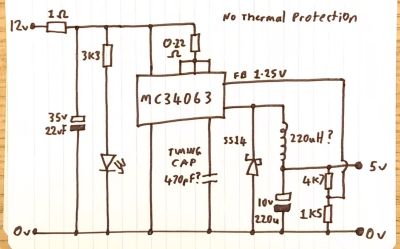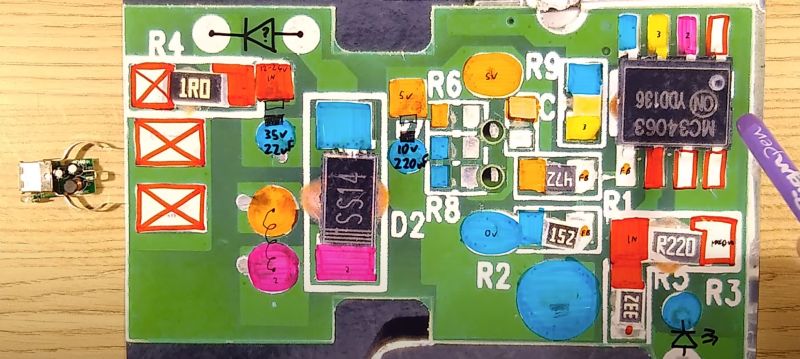
Generally when you crack open a cheap car-to-USB charger unit that came with some widget, you do not expect to find anything amazing inside. That’s why it was such a surprise to [Big Clive] when said car USB charger revealed a blast from the past in the form of an MC34063. This is a switching regulator that supports buck, boost and inverting topologies, but perhaps it most notable feature is that it was first produced by Motorola in the early 1980s.
This particular IC is marked as having been produced by ON Semiconductor which means that it’s technically still manufactured by Motorola – with ON Semiconductor being the Phoenix division that was spun off in 1999 – but it’s somewhat remarkable that this particular chip isn’t only produced by ON Semi today, but also by Texas Instruments. Much like the venerable NE555 timer IC and Intel’s 8051 MCU architecture, it would seem that certain chips and designs are simply made to become commodities in the future.
This appears to be the case for the MC34063 as well, which may lack some niceties of more modern ICs, such as built-in thermal protection, and it switches at only up to 100 kHz, but it can be bought for peanuts, has a wide input voltage range of 3 to 40 V, can switch up to 1.5 A and supports multiple common topologies. Often a 100 kHz switching regulator is all you need, in which case it’s handy to have a stack of such commodity chips lying around, plus the MC34063 comes in PDIP packaging as well, which is a boon for prototyping.
















Like opening a donut and finding a hole inside.
I think the point is specifically in the case of /which/ chip was found. It’s not common to see chips of that age in modern designs for power supplies — similar to how you’d not expect to find 78xx parts in modern consumer-grade equipment, because those parts are considered hobbyist-grade components nowadays. The famous 74xx and CD4xxx series chips on the logic side of things are something of an exception to this rule, but even that’s beginning to change a bit.
Also, you should probably be aware that BigClive — real name Clive Mitchell — is not merely “some guy”, and that Hackaday tends to interpret that word a bit… liberally… really for the benefit of most of the readership here. In regards to the latter, there’s all sorts of neat stuff we discuss here, from cyberdecks to developments of various sorts in the tech world, both consumer-side as well as supply-side, to retrotech, to dang near everything in between and around.
As for BigClive himself, he’s the fellow that gave the Joule Thief its name — and a good deal of its popularity — amongst many, many other things. You should check out his YouTube channel. He does very interesting stuff, from trying to carbonate all sorts of lovely things in a SodaStream that arguably aren’t supposed to be put into a SodaStream, to his usual teardown videos, to… rather exceptional teardowns, kit builds, all sorts of stuff. I’d argue he’s the premier world expert at this point on LED light bulb electronics, for one. Watching him reverse-engineer a power supply in real time is absolutely /fascinating/, and I still remember some years ago when he got hold of an electromechanical elevator controller built onto a slab of slate, no less, and waxed eloquent about it at quite a length — none of it even remotely boring.
But, hey, if none of that really excites you, no worries. I don’t judge, not on that at least, and there’s plenty of blogs out there. I hope you find one that suits you.
On the other hand, if you take a longer look around here and decide that maybe you really /do/ like what you see? Welcome! Enjoy your stay.
“I think the point is specifically in the case of /which/ chip was found. It’s not common to see chips of that age in modern designs for power supplies — similar to how you’d not expect to find 78xx parts in modern consumer-grade equipment, because those parts are considered hobbyist-grade components nowadays. The famous 74xx and CD4xxx series chips on the logic side of things are something of an exception to this rule, but even that’s beginning to change a bit.”
This is not true.
You absolutely would find it in various real products because it is so cheap, it is low frequency so amenable to crappy PCB layout and it’s cheap. Also, it’s cheap. It’s made by nearly every power IC manufacturer. Go to digikey, select PMIC and Buck.
You absolutely would find 78xx parts in all kinds of products for the same reason. Some of these type of parts do not require external capacitors for stability. There are parts that are better for different reasons (lower input-output drop, lower quiescent current), but more expensive.
The famous 74xx and CD4xxx are still very commonly used in all sorts of products. Hard to find a substitute for a mux, encoder or bilateral switch.
+10 (never knew that he named the Joule Thief)
BigClive, is that you? B-p
Those things don’t grow on trees! Then why are they so cheap?
This is the advantage of 30yr old technolgy. Production lines have already paid for themselves long ago, patents have expired and the process is optimized, so cost is reduced to raw material, maintenance and labor. It does have some similarities to “growing on trees”.
Title is a lil’ bit clickbaity, it’s interesting but NOT unexpected at all. Clive himself says the chip is “still going strong and is used in many products”, which is true: I’ve seen 34063’s in all kinds of power supplies, TVs, network equipment (especially cheap routers), car radios, even microwave oven controllers…
Granted, most are SMD clones from China but still.
Great comment. “…it would seem that certain chips and designs are simply made to become commodities in the future” is also a pretty shallow take written by someone probably running a Cortex M-1000 or so on battery power. Chip release is a business decision spurred by sales opportunities. I am 100% sure that Nordic Semiconductor didn’t just say “Oh hell, let’s invest $N and build the nRF51 series in case this BLE stuff catches on.”
I’ve taken apart several “automotive to USB-like” power supplies, and I think they have ALL had a MC34063 circuit inside. Presumably someone designed it to solve the “5V@500mA from 12V is a lot to expect from a linear regulator” problem, and that design has been widely cloned by … everyone. Probably the MC34063 chips have been cloned as well.
MC34963 are in cheap car voltage converters since forever. Even the old cigarette-lighter-to-Motorola/Nokia/Philips things had them, and they’re still around till today, because cheap and resilient to the many disturbances you’ll find on a car’s 12V line.
I also use them here and there.
“Costs Peanuts”
They seem to be about 11c each in bulk. A 250g packet of KP at Tesco costs £3. So that’s approximately 6g of peanuts per chip.
Given that peanuts really[1] do grow on trees, this is rather astonishing.
[1] Not really really, of course. Also peanuts can turn out to be really very expensive: https://en.wikipedia.org/wiki/Tanganyika_groundnut_scheme
I would have expected Clive to say “cheap as chips”, but that is as inappropriate today as “dirt cheap”.
Peanuts actually don’t grow on trees, they are legumes, grow underground. :-). So they are “dirt cheap”.
Ha, i already expected the hackaday article about it! I love when chargers use actual goo documented chips. A lot of the time i find a chinese chip with unreadable datasheet
What if you installed a zener for that missing diode. Could that help make it a bit safer regarding that shorted failure mode?
A TVS would be the appropriate part, but there’s not enough space inside these plugs to fit a proper sized one that can trip the fuse of the lighter socket. And then there’s another problem: most of these plugs work on 12V and 24V systems. So if you would fit a TVS for 12V, it will immediately explode if you use the plug in a truck with a 24V battery and a TVS for 24V is worthless on 12V.
No thanks, I will stick to +500kHz regulators with smaller passives and better efficiency.
I like the 500kHz part, but now try to find one that has a 40V input voltage and a real current limit and is also reasonably priced (30ct or so) and available from “western” distributors.
MC34063 is not used because of it’s accuracy or efficiency, but because it ticks a lot of other boxes, and if that does not suit you, then just use one that suits you better.
What’s unexpected about this? The vast majority of cheap USB car chargers, at least a decade ago when I was in the habit of tearing them apart, had an ‘063 inside. To the degree that I have a bin of them at the hackerspace, labeled:
“MC34063 EXAMPLE CIRCUITS and other lighter-socket usb chargers”.
i love his “The lamps you’re not allowed to have. Exploring the Dubai lamps” episode.
Dear Phillips, if you want to sell your goods in our kingdom, your lamps must not have a planned obsolescence built in, on the contrary, the circuit must be durable and an emergency second circuit must be integrated. It must have a maximum light output with minimum power consumption.
How the world can be when the good rule ;-)
“The lamps you wouldn’t want to buy if they weren’t heavily subsidized” would have been more appropriate. But I guess you cannot make a living with a YT channel without lowering your standards to tabloid level.
Tabloid is a size of paper BTW, not a quality of the content printed upon it. There are better allegories you can use.
> How the world can be when the good rule ;-)
Durable LEDs do not give the rulers of Dubai a free pass.